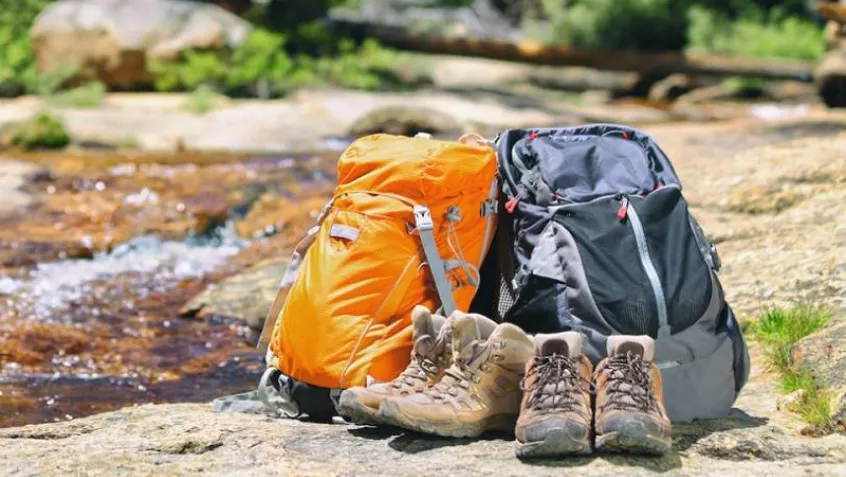
July is National Park and Recreation Month—a time to celebrate the benefits of your local parks and favorite outdoor activities. And this year, there's even more to celebrate. Over the past 18 months, many Americans discovered the fun of exploring public lands for the first time as they turned to safe, socially-distant activities during the COVID-19 pandemic.
An October 2020 poll found that close to 70% of Americans now have an increased appreciation for the outdoors. Another survey reported that one-third of leisure travelers who had not camped before said they were now interested in camping.
But getting outside requires gear. According to the Wall Street Journal, sales of camping gear surged 25% during the third quarter of 2020. And with a wide range of outdoor recreation activities available, from bicycling to rock climbing to snow sports, all that gear can really add up.
The Hidden Plastics in Outdoor Gear
The COVID-19 pandemic put a new emphasis on the role of plastics in our daily life, from PPE to single-use utensils and plastic bags. However, you may be surprised to learn that plastic is also a major component of many types of outdoor gear, from puffy jackets to climbing ropes and tents.
Research shows that the US is one of the top generators of plastic waste in the world. Outdoor gear represents one small piece of a larger plastic waste pie. But no matter its original use, most plastic used in North America ultimately ends up in landfills.
The plastic used in outdoor gear has other negative impacts, too. Outdoor equipment, like most clothing, contains synthetic fabrics such as nylon and polyester that are made from thin plastic fibers. These man-made substances can have an impact on the environment where they are used.
For example, researchers found synthetic chemicals in snow and ice samples taken from Mount Everest, shed from waterproof gear used by decades of climbers. A 2017 study concluded that 35% of all microplastics in the ocean originated from synthetic textiles.
The Circular Economy
Just as many people have moved away from “fast fashion”—inexpensive clothing that encourages consumption—outdoor enthusiasts are also considering ways to reduce the impact of their gear.
The “circular economy” is a concept focused on designing out waste and pollution in supply chains and reusing materials whenever possible rather than consuming finite resources. Outdoor companies are using this model to analyze their processes and the materials they use.
For example, the Higg Index is a standardized way to measure sustainability throughout the apparel supply chain. Manufacturers and consumers can use this tool to better understand the water use, carbon emissions, and labor conditions used in the apparel industry. Brands can take the extra step to become Climate Neutral Certified, calculating and offsetting their carbon emissions with credits purchased from carbon-eliminating projects.
Some ways that manufacturers have lessened their environmental impact include turning recycled plastics into “upcycled” textiles, improving water efficiency in their operations, and offering repairs to their products to help them last longer. And with the recent increase in online shopping due to the pandemic, some companies have reviewed their shipping practices to reduce their reliance on plastic packaging.
Another Way to Leave No Trace
Of course, no matter the material, every product we use has an environmental impact of some kind. But another way to leave no trace is being mindful of where products originate—and how much we consume.
Are you a self-described gear head? Or are you in the market to get outfitted for a new outdoor hobby? Consider these tips to help reduce your environmental impact:
- Educate yourself. Understand how the materials used in outdoor gear can affect the environment and research how your favorite brands are working toward sustainability goals.
- Start small. If you are new to the outdoors, start by exploring local parks and activities like day hiking that require minimal gear.
- Buy used. Trying out a new outdoor sport or looking to go camping for the first time? Buy used gear to save money and give new life to old gear while determining if this will become a long-term hobby.
- Rent from a gear library. Many local outfitters or websites provide options to borrow or rent gear rather than purchasing new.
- Buy quality gear. Invest in durable products that will last a long time rather than “fast fashion” that is trendy or cheap at the moment but will wear out quickly.
- Recycle. Consider choosing products made from recycled or “upcycled” materials and recycle, donate, or repurpose your used clothing or gear once you've outgrown it or have moved on to a new hobby.
- Reduce microfiber pollution. Follow these six recommendations from NEEF and the EPA to reduce the release of microfibers through your laundry.
There's Never Been a Better Time to Get Outdoors
A March 2021 survey showed that 75% of those who experienced the outdoors for the first time during the COVID-19 pandemic want to continue to stay engaged in outdoor activities in the future. (Perhaps you are one of them!)
As you shop for the gear that will help you get outside, remember that being an environmentally-conscious consumer is a win-win: in the long-term, it saves you money while conserving natural resources.


